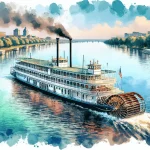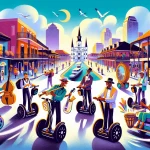New Orleans, a place renowned for its captivating culture and lively spirit, boasts an iconic mode of transportation: the streetcar. With a legacy stretching back to the early 19th century, streetcars have been an integral part of the city’s transportation network, offering residents and visitors a convenient and charming way to explore the vibrant streets of the Big Easy. Mastering the essential streetcar routes is key to navigating New Orleans efficiently and experiencing the best it has to offer.
In This Article
TL;DR
- New Orleans streetcars provide a historic and practical way to travel around the city
- The St. Charles, Canal Street, and Riverfront lines are the essential routes to know
- Understanding these routes and their connections helps travelers explore the city seamlessly
St. Charles Streetcar Line
The St. Charles Streetcar Line, the oldest continuously operating streetcar line in the world, is a must-experience for anyone visiting New Orleans. This historic route runs from downtown to Uptown, passing through the picturesque Garden District. The line’s distinctive green streetcars, many dating back to the 1920s, offer a glimpse into the city’s past while providing a practical means of transportation.
Key stops along the St. Charles line include:
- Audubon Park: A beautiful 350-acre park featuring walking trails, a golf course, and the Audubon Zoo
- Tulane University: One of the most prestigious private research universities in the United States
- Loyola University: A Jesuit university known for its academic excellence and commitment to service
The St. Charles line connects with the Canal Street line at the intersection of Canal and Carondelet streets, making it easy for riders to transfer between the two routes.
Canal Street Streetcar Line
The Canal Street Streetcar Line is another essential route, running from the French Quarter to Mid-City and City Park. This line is particularly useful for visitors looking to explore some of New Orleans’ most renowned attractions, such as Bourbon Street and the historic cemeteries.
Key stops along the Canal Street line include:
- Bourbon Street: The heart of the French Quarter, known for its lively nightlife, music venues, and restaurants
- The Cemeteries: New Orleans’ iconic above-ground cemeteries, including St. Louis Cemetery No. 1 and Lafayette Cemetery No. 1
- City Park: A sprawling 1,300-acre park featuring the New Orleans Museum of Art, the New Orleans Botanical Garden, and numerous walking trails
The Canal Street line connects with the St. Charles line at Canal and Carondelet streets and offers transfers to the Riverfront line and various bus routes.
Riverfront Streetcar Line
The Riverfront Streetcar Line runs along the Mississippi River, providing a scenic route from the French Quarter to the Convention Center. This line is perfect for those looking to explore the city’s riverfront attractions and the Warehouse and Arts Districts.
Key stops along the Riverfront line include:
- The French Market: A historic open-air market featuring local produce, crafts, and food vendors
- Aquarium of the Americas: A world-class aquarium showcasing the diverse marine life of the Americas
- Harrah’s Casino: A popular gaming and entertainment destination
The Riverfront line connects with the Canal Street line at the foot of Canal Street, making it easy for riders to transfer between the two routes.
Navigating the Streetcar System
To make the most of your streetcar experience, it’s essential to understand how to navigate the system. Streetcar route maps and schedules are available at various locations throughout the city, including on the streetcars themselves and at major stops. Fares can be purchased on board the streetcars using exact change or via the RTA GoMobile app.
When boarding a streetcar, wait for the vehicle to come to a complete stop and for exiting passengers to disembark before stepping on. To request a stop, pull the cord located along the windows or near the seats. Be sure to hold on to the handrails or seat backs while the streetcar is in motion, as sudden stops or turns can cause passengers to lose their balance.
Streetcar Etiquette and Tips
To ensure a pleasant experience for all riders, it’s important to observe proper streetcar etiquette. This includes:
- Offering seats to elderly, disabled, or pregnant passengers
- Keeping luggage and large items out of the aisles and doorways
- Refraining from eating, drinking, or smoking on the streetcars
- Keeping noise levels to a minimum and using headphones when listening to music or watching videos
During peak hours, typically during morning and evening rush hours, streetcars can become crowded. If possible, plan your trips outside of these times to avoid overcrowding and ensure a more comfortable ride.
Streetcar Attractions and Sightseeing
New Orleans’ streetcars not only provide transportation but also offer a unique way to explore the city’s many attractions. Each route passes by notable landmarks and points of interest, making it easy for visitors to combine streetcar rides with walking tours or other sightseeing activities.
Some notable attractions accessible by streetcar include:
- The National WWII Museum (St. Charles line)
- The New Orleans Museum of Art (Canal Street line)
- The Ogden Museum of Southern Art (St. Charles line)
- The Shops at Canal Place (Riverfront line)
Streetcars also provide access to seasonal events and festivities, such as the Mardi Gras parades along St. Charles Avenue or the Celebration in the Oaks holiday light display in City Park.
Streetcar Accessibility and Limitations
While New Orleans’ streetcars are an integral part of the city’s transportation system, they do have some limitations in terms of accessibility. Most streetcars are not equipped with wheelchair lifts or ramps, making them challenging for individuals with mobility issues to board and disembark.
Additionally, streetcars have limited space for bicycles and do not allow pets on board, with the exception of service animals. For those unable to use the streetcars due to accessibility concerns, the RTA offers a paratransit service called RTA Paratransit, which provides door-to-door transportation for individuals with disabilities.
The city is continually working to improve accessibility within the streetcar system, with plans to introduce new, more accessible vehicles in the future.
New Orleans’ streetcars offer a unique and efficient way to explore the city, with essential routes like St. Charles, Canal Street, and Riverfront lines connecting riders to the city’s most iconic attractions and neighborhoods. By understanding the routes, navigating the system, and observing proper etiquette, visitors can make the most of their streetcar experience and immerse themselves in the rich history and culture of the Big Easy.






